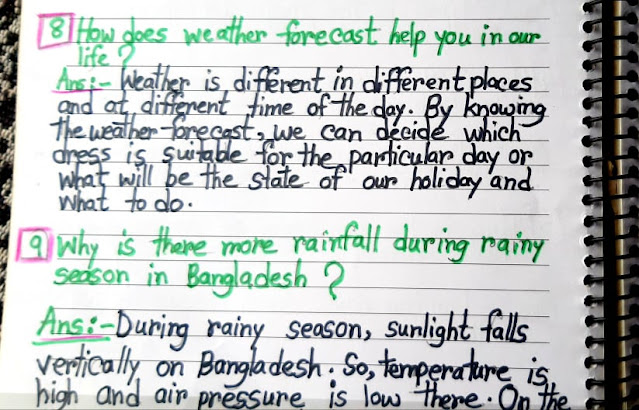Weather and Climate:
Class- 4
Q.1. Write the names of the components of weather.
Ans: The components of weather are-i) sky conditions,ii) temperature,iii) humidity andiv) wind.
Q.2. What is the difference between fog and dew?
Ans: Fog is a cloud that appears near the ground or touches the ground. Dew is deposit of water drops that is formed on cold surfaces by condensation of water vapors in the air.
Q.3. What is the difference between weather and climate?
Ans: Weather is the condition of sky and the atmosphere of a place for a short time. On the other hand, climate is the general condition of weather of a place for many years.
Q.4. Explain how clouds are formed.
Ans: Sea or river water evaporates due to the heat of the sun and it becomes water vapour. When water vapour in the air is cooled, water vapour condenses on a tiny dust form a small water droplet. These small water droplets float in the sky as a cloud.
Q.5. What are the problems of heavy rainfall?
Ans: The problems of heavy rainfall are-
a) roads go underwater
b) flooding
c) disrupt transport and communication
d) loss of crops and livestock
e) risk of human life
Q.6. Describe the climate of Bangladesh.
Ans: In general, the climate of Bangladesh is classified as hot and humid climate. The annual average temperature of Dhaka in Bangladesh is 26 degree Celsius. Seasonal pattern in Bangladesh is different from other countries in the northern hemisphere. There are six seasons such as Summer, Rainy season, early Autumn, late Autumn, Winter and Spring.
Science
Grade-5
Chapter-11
Q.1. What is weather?
Ans: Weather is the temporary state of sky and the atmosphere at a certain place.
2. What is climate?
Ans: Climate is the condition of weather of a place for many years.
3. What is the main difference between weather and climate?
Ans: Time is the main difference between weather and climate.
4. How is the condition of land during day time?
Ans: During day time land is warmer than the water.
5. How is the condition of ocean during night time?
Ans: During night time ocean is warmer than the land.
6. What are the components of climate?
Ans: The components of climate are -I) temperatureii) humidityiii) windiv) cloudv) rainvi) air pressure
7. When does air blow from the ocean to land?
Ans: Generally in rainy season i.e. June - August the land of Bangladesh is warmer than the Bay of Bengal. That is the reason, the wind of the high pressure area of ocean blows to low pressure area of land.
Forcasting :
Activity of judging what is likely to happen in the future, guessing projecting, anticipating, calculating.
Altitude refers to the height above sea level.
Temperature decreases with increasing height above sea level. this makes the higher areas to have lower temperatures than the lower areas.
8. How does weather forecast help you in our life?
Ans: Weather is different in different places and at different time of the day. By knowing the weather forecast, we can decide which dress is suitable for the particular day or what will be the state of our holiday and what to do.
9. Why is there more rainfall during rainy season in Bangladesh?
Ans: During rainy season, sunlight falls vertically on Bangladesh. So, temperature is high and air pressure is low there. On the other hand Bay of Bengal is in high air pressure. So the southwest seasonal wind flows from there towards Bangladesh and carries much water vapour. These vapour cool down and falls on earth as rain. This is why there is more rainfall during rainy season in Bangladesh.
10. How do weather and climate alike and different?
Ans: Weather and climate are alike for the following reason -The components of weather and climate are the same, such as temperature, humidity, wind, cloud and rain and air pressure.Weather and climate are different for the following reasons -There is a close relation between climate and weather but they are not same.Weather is the condition of sky and the atmosphere of a place for a short time. On the other hand, climate is the general condition of weather of a place for many years.
Climate in particular area depends mainly on area's latitude, its altitude, and distance from the sea.
Q.1. What is equator?
Ans: An imaginary line running around the widest part of the Earth, halfway between the North Pole and the South Pole.
Q.2. What is latitude?Ans: The latitude is the distance from the equator. Near the equator, the Sun's rays shine straight down. The Sun's warms the surface of the near equator. The higher the latitude, the colder the climate is.

















Comments